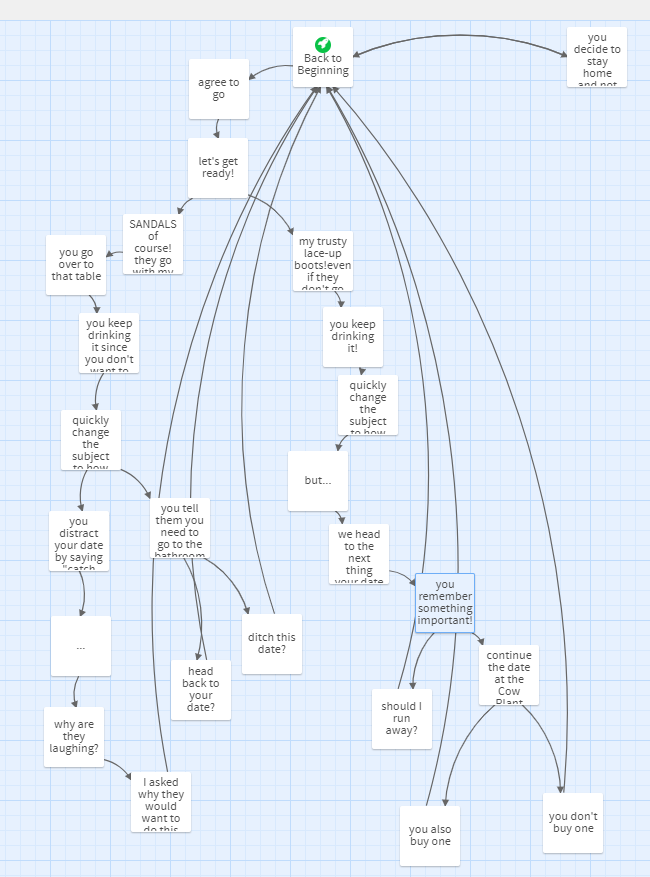Mermaid Blind Date
Above is the link to my Twine story. It’s a VERY random story I came up with off the top of my head. It’s more like a guided dating simulation story with different endings depending on your limited choices. If I had more time I would have added some pictures and sounds to make the story more immersive. This was my first time using Twine and I did have some difficulty with what to do initially. I started off trying to create a story using a pen and paper to organize my thoughts. My first idea had many choices at the beginning and I found that I was easily overwhelmed with having too many hypertext choices and decided to simplify it to just 1 or 2 choices each time. I decided to forgo using my pen and paper pretty early on and went to directly creating on Twine. I find that “electronic writing is flexible and interactive [which means that] it is hypertextual” (Bolter, 2001). This helped with my organization and helped me decide to keep it as simple as possible. I didn’t make too many forks in the story, so you’ll notice that it’s a bit more linear in the image below.

I found it interesting to see how thought out and different other classmates Twine games were. Classmate Deirdre created an interesting and immersive game with their drawings and sound effects with some added humour to make it more light hearted. They mentioned in their post about how the use of hypertexts in Twine helped make the creation process and organization of their story/game less overwhelming (Bolter, 2001). I did find that it was a lot less overwhelming and less daunting using this digital tool as well. However, the learning curve to do certain actions on Twine was a bit steep personally. If I had more time I would have definitely invested it in using more hypertexts to simplify my story and make it more interactive and flow better.
I wanted to make my Twine as informal as possible and one of the active things I did to ensure that was to have a lack of capitals at the beginning of my sentences. According to McCulloch (2019) in The Allusionist podcast, the deliberate decision to not have capitals at the beginning of sentences can be seen as a change in tone. Language is always changing because humans who use language are always in flux, thus its important to recognize and accept that language will change and is always changing with the use of technology. I decided to keep it informal because I wanted to make it as casual of a story as possible – something that is seen as light hearted and a bit silly. I’m sure I could have added more minimalist typography to add to making it more informal.
One thing I noticed while using Twine was the lack of autocorrect or spellcheck. I didn’t have to fight against the machine to achieve the lack of capital letters. McCulloch (2019), mentioned how autocorrect can make us more conservative in our writing and thinking and how word processors have shifted the way we think about words and how they are perceived. Autocorrect is also a faster way to write and therefore most people go with the flow of it. The act of going against the machine is more effort and thus seen as something more positive in informal contexts. Would the fact that I wrote in just lower case letters be seen as writing for the future or writing for the past (McCulloch, 2019)? Maybe the way I wrote for my Twine will be seen as rude in the future. I’m curious to see how certain typography will be used to portray different tones, emphasis to symbolize meaning and emotions in the future.
References:
Bolter, Jay David. (2001). Hypertext and the remediation of print. In Writing space: computers, hypertext, and the remediation of print. Routledge. (pp.26-46)
The Allusionist #102 New Rules, Helen Zaltzman interviews Gretchen McCulloch, Internet linguist (2019).
